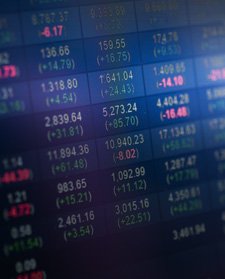
Advantage AxisDirect
- 20 investment products
- 3 great platforms to invest
- 5 fun-tastic learn courses
- 5 powerful research segments
- 4 prestigious awards
- 9 lakh+ happy investors
Quotes
Back To Menu
-
Offerings
- Markets
- Research
- Learn
- PORTFOLIO
Derivatives Trading and SEBI – AxisDirect
AxisDirect-O-Nomics
Dec 28, 2017 | Source: Livemint

Derivatives Trading in India
Indian equity investors have an inexplicable fetish for complex derivative products. In FY2017, just 700,000 individuals bought and sold nearly $4 trillion notional worth of derivatives. This is twice as much as all foreign institutional investors in India combined. India’s stock exchanges trade eight times more equity derivatives than the Hong Kong (HK) stock exchange, even though the value of all companies listed in HK is double that of India. Indian retail investors also seem to prefer the riskier of the two categories of derivatives products between stock futures and options. The potential gain or loss in futures is unlimited, while it is limited in options. Retail investors in India bet on a notional value of $800 billion of stock futures in 2016, more than the value of stock futures traded in all of Europe, Hong Kong and Singapore combined. Retail investors account for half of all the stock futures trading in India, while sophisticated institutional investors account for just one-tenth and prefer stock options instead. Not only do Indian retail investors have a puzzling fascination for high-risk derivative products, they seem addicted to the riskiest category. Why do these retail investors indulge in such excessive derivatives trading?
In theory, derivatives are a product designed for hedging risk. If an investor owns shares of Infosys and wants to minimize risk, he can hedge his risk by buying or selling Infosys futures or options. Alternatively, one can buy or sell Infosys futures or options without owning any shares, just to punt on its price movement, speculators as they are called. Any equity derivatives market is a delicate balance between these hedgers and speculators. Are Indian retail investors in derivatives speculators or hedgers?
Two-thirds of non-promoter shares in listed Indian companies are owned by foreign and domestic institutions, while retail investors own a mere one-sixth. Yet institutional investors account for a mere one-tenth of all derivatives trading in India while retail and proprietary traders, who don’t own as many shares as institutions, account for 90%. So it can be imputed that the bulk of the derivatives trading by retail investors is not to hedge their stock positions (which are minimal) but to speculate on price movements. India’s equity markets are dominated by small investors speculating heavily through trading in high risk derivatives. The logical follow-up question is—so what? Some may argue that it is the individuals’ choice to risk their money. True, but it is equally important to ask what the negative externalities of such excessive derivatives trading are. In other words, is there a looming systemic risk or potential dangers to others arising out of the highly speculative nature of the Indian equity markets?
It is not our contention that retail investors will lose $4 trillion if the markets turn sour. But the financial risks are tangible and unpredictable. Given the 2008 ‘Black Swan’ event experience, it is clear another similar event can lead to catastrophic consequences for these investors and cascade down to the larger market. That derivatives can cause extreme losses that one cannot quantify or foresee is an indisputable truth. It is, then, only appropriate that steps be taken to amend this skew rather than wait for it to implode and clean up the mess later.
Beyond the financial risk, there are other intangible effects of high derivatives trading. Speculative investors in a market only attract other speculators. The sheer dominance of such speculative investors in India’s equity markets has lent it the character of a “speculative den”, which is corroborated by Sebi’s household investor surveys. Households’ trust in equity markets is abysmally low, according to the survey. The number of retail investors, either directly in the markets or indirectly through mutual funds, has remained roughly flat for a decade. Indian households have largely shunned participation in equity markets out of fear of the “casino”. Companies are able to raise only as much capital on India’s stock exchanges as they did a decade ago. Mutual funds have only doubled the amount of capital raised from Indian households over an entire decade. But derivatives trading has gone up 30 times. So derivatives have not helped achieve the goal of making markets more efficient and enabling companies to raise more capital. If anything, it is hurting this very objective.
Increase in contract size
When derivatives were introduced in 2000, the minimum contract size was set at Rs2 lakh. Since then, the average Indian’s income has increased five times, the total value of all companies on the stock exchanges has risen 20 times and the BSE Sensex has gone up 10 times. But the minimum contract size for derivatives was increased to only Rs5 lakh, just two years ago. The minimum contract size can further be doubled to Rs10 lakh, which will be in line with the increases in other market parameters. This will ensure that the bar for small investors indulging in excessive risk-taking in derivatives is raised significantly.
Substantially increase margin requirements on options
According to the Sebi paper, most retail investors indulge in selling derivatives (options) to collect the upfront cash they can garner. For most individual investors, the idea of receiving cash for initiating a trade is exciting but it is fraught with big risks. Investor education and other clichéd solutions aside, the best way to stop investors from harming themselves is to increase the cost of pursuing such strategies. For writing options, it would be more prudent to prescribe a margin of 25% of the notional value or the currently existing formula, whichever is greater.
Transaction tax rationalization
Taxation is not under the purview of Sebi, so this may be an inappropriate policy recommendation for it. Nevertheless, transaction tax arbitrage between stocks and derivatives is the fountain-head for India’s distorted market structure today. Hence, it is important to address this and ensure there is parity in transaction taxes between stocks and derivatives by increasing transaction taxes on derivatives.
Accredited investor regime
With the advent of Aadhaar and other databases, it is now possible to determine the risk profile of an investor much more easily. It is then important to usher in an accredited investor framework to determine product eligibility for an investor based on their income levels and risk profile. A proper accredited investor regime based on one’s income-tax returns and Aadhaar will create a more robust eligibility framework for investing in risky products.
Related Keyword
Trading
Derivatives
Options
SEBI
AxisDirect-O-Nomics
Similar Articles
Show more...vV5.0.0.6-60 Thanks for Liking, Please spread your love by sharing...As you have logged in from a different device/browser. This session has expired.Image size cannot exceed 512 KB. - Markets




 INDIA
INDIA NRI
NRI












